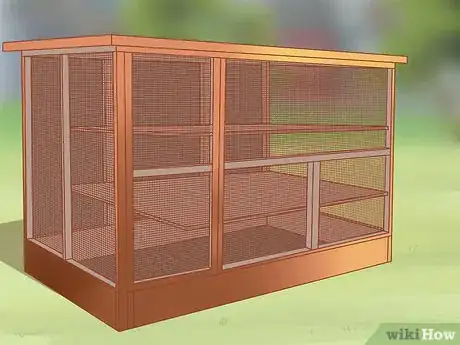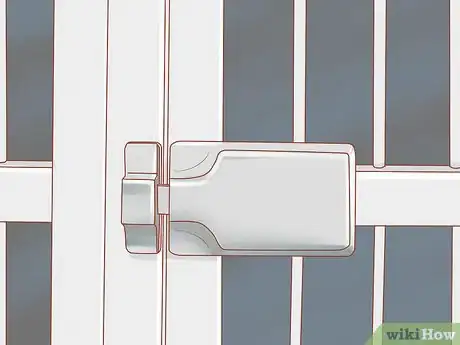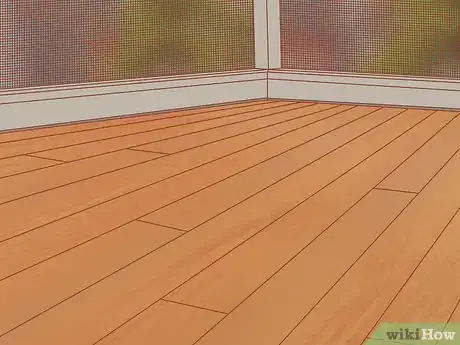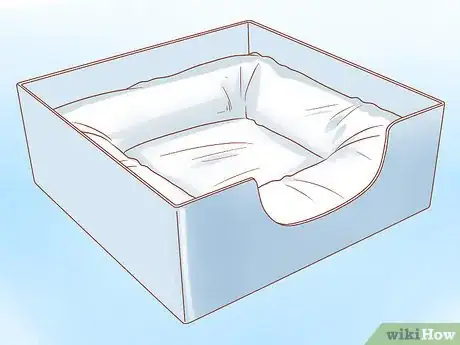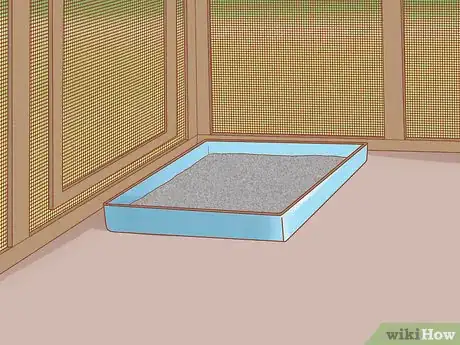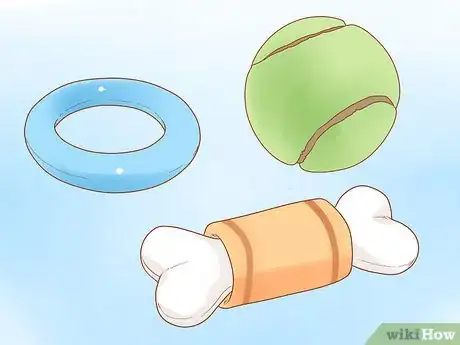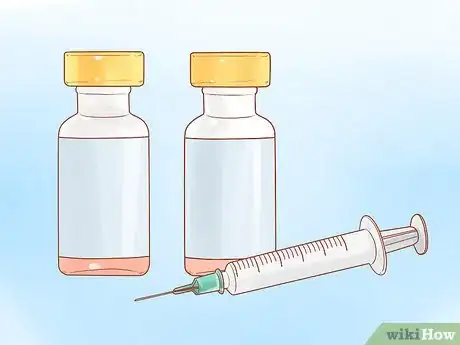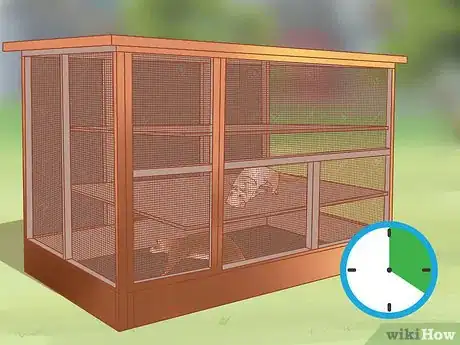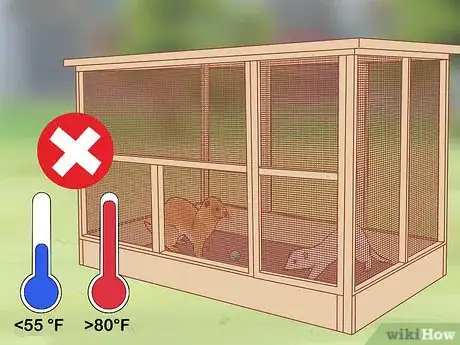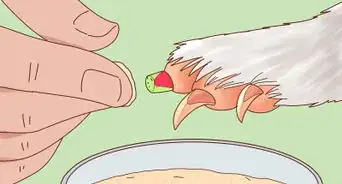This article was co-authored by Pippa Elliott, MRCVS. Dr. Elliott, BVMS, MRCVS is a veterinarian with over 30 years of experience in veterinary surgery and companion animal practice. She graduated from the University of Glasgow in 1987 with a degree in veterinary medicine and surgery. She has worked at the same animal clinic in her hometown for over 20 years.
This article has been viewed 44,562 times.
If you have 1 or more pet ferrets but don’t want them to live in your house, you’ve probably considered moving them outdoors. Ferrets can be very happy in an outdoor habitat, provided the habitat is secure and all of their needs are met. To move your ferrets outside, set up an outdoor enclosure with all the amenities that ferrets need. Then, all you have to do is make sure your ferrets are safe from illness, inclement weather, and the urge to escape!
Steps
Choosing an Outdoor Enclosure
-
1Buy an outdoor enclosure that measures 6 by 6 by 6 feet (1.8 by 1.8 by 1.8 m). A habitat this big can comfortably house between 1 and 3 ferrets. Go with an enclosure or hutch for small animals, such as a large rabbit hutch. You can also opt to build the enclosure yourself out of wooden frames and mesh panel siding if you have construction experience.[1]
- You can buy this type of outdoor enclosure from most large pet supply stores, such as PetSmart or Pet Supplies Plus.
- Building the enclosure yourself is a little difficult, so if you don’t have any construction experience, your best bet is to buy a pre-made enclosure.
- Avoid buying or building an enclosure smaller than 6 by 6 by 6 feet (1.8 by 1.8 by 1.8 m). Your ferrets will not be happy with their outdoor home if they feel cramped in it.
- If you plan to house more than 3 ferrets in your outdoor enclosure, add 2 feet (0.61 m) to each dimension for each additional ferret. For example, if your habitat will house 4 ferrets, go with an enclosure that measures 8 by 8 by 8 feet (2.4 by 2.4 by 2.4 m).
-
2Make sure the holes in the siding are smaller than 1 by 1 inch (2.5 by 2.5 cm). If the space between the bars of your enclosure are bigger than this, your ferret will probably be able to escape through them. You should still opt for mesh panel siding, but only if the holes in the panel aren’t too big.[2]
- You can usually buy mesh panel siding at home improvement stores and stores that sell gardening supplies.
Advertisement -
3Get an enclosure with multiple levels to keep your ferrets entertained. A habitat with 2-4 different levels will provide your ferrets with stimulation and the ability to run around and burn off energy. Be sure there are ramps that go between the levels so your ferrets can easily run between them.[3]
- The more ferrets you have in your habitat, the more levels it should have. Aim to have at least 1 level per ferret.
-
4Opt for an enclosure with a secure locking mechanism. Ferrets are pretty good at escaping from their enclosures, so your outdoor habitat needs to have a door with a very secure latch on it. The latch should be strong enough to prevent your ferrets from simply pushing or pulling the enclosure door open.[4]
- If you want to add extra “security” to the enclosure doors, try using binder clips or clamps to better hold the doors in place.
-
5Make sure that your enclosure offers protection from the elements. Even if your ferrets are protected from extreme temperatures, they also need to have dry shelter during heavy rains and protection from direct sunlight. The best way to do this is to place a solid wooden panel over the top of the enclosure and put a smaller “mini shed” in the interior somewhere.[5]
- Place the enclosure somewhere out of the prevailing wind. Ideally, the enclosure should be protected on 1 or 2 sides by a wall.
Setting up Your Outdoor Habitat
-
1Place solid flooring on the bottom of the enclosure. If you bought a prefabricated hutch, it probably already has a solid wooden floor that will keep your ferrets from digging through the bottom. If you built your own enclosure, use concrete slabs or wooden flooring to make a solid floor for the habitat.[6]
- Ferrets love to dig and would easily escape the enclosure if you leave the bottom of it exposed to the ground.
-
2Set up food and water containers in the corner of the enclosure. Use either an open tray or a small animal gravity feeder to provide food for your ferrets. Similarly, place a clip-on water bottle on the side of the enclosure or an open tray on the ground for your ferrets’ water.[7]
- If you use an open tray for your ferret’s water trough, make sure it has considerable weight to it and isn’t top-heavy. Otherwise, your ferret may tip it over.
-
3Lay down bedding in a separate corner for a sleeping area. This could be blankets, straw, hay, or even old clothes you have lying around. However, your ferrets would particularly enjoy a cozy hammock with a pouch in it that they can snuggle up and sleep inside.[8]
- You can buy cozy ferret hammocks at any pet store that sells ferret supplies.
- You can also opt to use a nest box filled with a fleece blanket or a simple cat bed.
-
4Place a litter box with a low entrance in a third corner of the enclosure. This will be where your ferrets go to use the bathroom. Ferrets don’t like to use the bathroom where they sleep or eat, so place this litter box on the opposite corner from where its food is located, if possible.[9]
- You’ll need to fill the litter box with a strong odor-fighting litter, since ferret waste smells pretty strong.
- Use litter that is specifically designed for use with ferrets. For best results, go with pelleted litter, since this type of litter tends to be highly absorbent and easily scooped.
-
5Put toys, tubing, and other things your ferrets can play with in the cage. Your ferrets will definitely want to play and be entertained while they’re in the enclosure, especially if you won’t be around very much. Use cat toys that appeal to your ferrets’ hunting instincts, such as toy mice and balls, as well as tunnels and tubes for them to crawl through.[10]
- Any tunnels or tubes you buy for your ferret habitat should be at least 6 inches (15 cm) in diameter.
- You can buy most of these toys at any large pet supplies store.
Keeping Your Ferret Safe and Healthy
-
1Get your ferrets’ vaccinations up to date before moving them outside. Being outside will expose your ferrets to harmful viruses and diseases, like distemper and rabies. Take your ferrets to the vet and get them vaccinated for these and any other applicable illnesses before moving them into the outdoor enclosure.[11]
- You will also need to treat your ferrets with a preventive medicine to repel mosquitos, since mosquitos carry larvae that can infect your ferrets with heartworm.
-
2Acclimate your ferrets to staying outdoors gradually. If your ferrets are used to living solely indoors, they’ll need time to adjust to their new environment. Start by putting them outside for 20 minutes each day for a few days, and then gradually increasing the amount of time they spend outdoors.
- Choose a time when the weather is mild (preferably between 55 to 80 °F (13 to 27 °C) and not too windy or rainy) to start acclimating your ferret to the outdoors. This will help make the transition less stressful for them.
-
3Avoid leaving your ferrets outside in extreme temperatures. Ferrets can live outside comfortably in temperatures ranging from 55 to 80 °F (13 to 27 °C). However, when the temperature outside goes above or below this range, move your ferrets indoors.[12]
- During winter, you can also opt to put an animal-safe heater in your ferret enclosure, provided it gets the internal temperature up to at least 55 °F (13 °C).
-
4Refrain from using fertilizer or weed killer near the enclosure. These chemicals can be very harmful to ferrets if they ingest them. If you do have to use fertilizer or weed killer around the enclosure, only use spray versions of the chemicals and wait at least 24 hours before moving your ferrets into the enclosure to allow the chemicals to dissipate.[13]
- Granular fertilizers won’t dissolve quickly and so should be avoided entirely for best results.
-
5Keep an eye on your enclosure in case your ferrets escape. Even if your enclosure is pretty secure, ferrets are master escape artists, so it’s useful to monitor their enclosure pretty regularly. If possible, make it a point to check on the enclosure every hour or so and make sure the ferrets are still inside it.[14]
- If one of your ferrets does manage to escape, contact local animal shelters and animal control agencies at once and let them know that your pet is missing.
Things You’ll Need
- Enclosure or hutch measuring at least 6 by 6 by 6 feet (1.8 by 1.8 by 1.8 m)
- Open trays or gravity feeders for food and water
- Bedding
- Litter box
- Toys and tubing
Warnings
- Make sure the climate where you live is appropriate for ferrets to live outside. Ferrets are very susceptible to heat stroke and could easily die if the temperature rises to 90 °F (32 °C) outside.⧼thumbs_response⧽
- Similarly, if your area gets a lot of snow and freezing temperatures in the winter, be sure to either bring the ferrets in during this weather or set up pet-safe heaters in the habitat.⧼thumbs_response⧽
- Talk to your vet before placing any plants inside your ferret enclosure, as some may be harmful for your ferret to be around.⧼thumbs_response⧽
References
- ↑ http://wildpro.twycrosszoo.org/000ADOBES/Ferrets/D402_ferret_enclosures_FERT.pdf
- ↑ http://wildpro.twycrosszoo.org/000ADOBES/Ferrets/D402_ferret_enclosures_FERT.pdf
- ↑ https://www.ferret.org/pdfs/education/cages.pdf
- ↑ https://www.ferret.org/pdfs/education/cages.pdf
- ↑ https://www.exoticdirect.co.uk/news/can-a-ferret-live-outside-ideal-outside-temperature-cold-hot-weather-housing
- ↑ http://wildpro.twycrosszoo.org/000ADOBES/Ferrets/D402_ferret_enclosures_FERT.pdf
- ↑ http://wildpro.twycrosszoo.org/000ADOBES/Ferrets/D402_ferret_enclosures_FERT.pdf
- ↑ https://www.exoticdirect.co.uk/news/can-a-ferret-live-outside-ideal-outside-temperature-cold-hot-weather-housing
- ↑ https://petopedia.petscorner.co.uk/looking-after-ferrets/
- ↑ https://petopedia.petscorner.co.uk/looking-after-ferrets/
- ↑ https://weaselwords.com/ferret-articles/outdoor-dangers/
- ↑ https://weaselwords.com/ferret-articles/outdoor-dangers/
- ↑ https://weaselwords.com/ferret-articles/outdoor-dangers/
- ↑ https://www.exoticdirect.co.uk/news/can-a-ferret-live-outside-ideal-outside-temperature-cold-hot-weather-housing
About This Article
To move ferrets outdoors, you'll need to keep them in a large, secure enclosure, like a rabbit hutch. To protect your ferrets from the elements, make sure their enclosure is sheltered from rain, wind, and direct sunlight. You should also line the bottom of the enclosure with bedding, set up food and water containers inside, and provide a litter box in one of the corners. Once you've set up the enclosure, gradually acclimate your ferrets to living outdoors by bringing them out for 20 minutes a day. For tips on how to choose a secure enclosure for your ferrets, read on!


